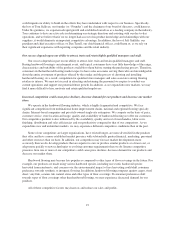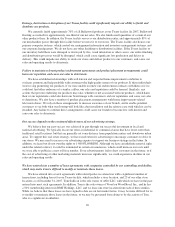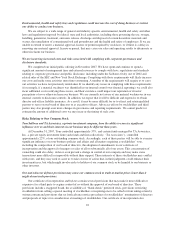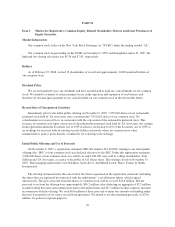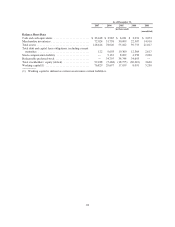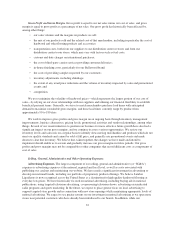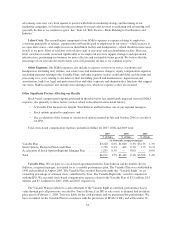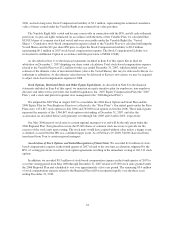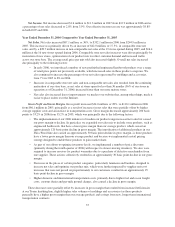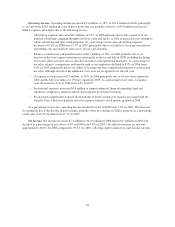Lumber Liquidators 2007 Annual Report Download - page 35
Download and view the complete annual report
Please find page 35 of the 2007 Lumber Liquidators annual report below. You can navigate through the pages in the report by either clicking on the pages listed below, or by using the keyword search tool below to find specific information within the annual report.Item 7. Management’s Discussion and Analysis of Financial Condition and Results of Operations.
Overview
Lumber Liquidators is the largest specialty retailer of hardwood flooring in the United States, based on
industry sources and our experience. We believe we have achieved a reputation for offering great value, superior
service and a broad selection of high-quality hardwood flooring products. We offer an extensive selection of
premium hardwood flooring products under multiple proprietary brands at everyday low prices designed to
appeal to a diverse customer base. We believe that our vertically integrated business model enables us to offer a
broad assortment of high-quality products to our customers at a lower cost than our competitors. We believe that
our brands, value proposition and integrated multi-channel approach are important competitive advantages.
We offer our products through multiple, complementary channels, including 116 Lumber Liquidators stores
in 43 states at December 31, 2007, a full-service call center in Toano, Virginia, our website and a catalog. The
growth in our net sales has been driven by new store openings and our strong comparable store net sales
performance. We have opened over 50% of our total store base in the past three years, including 25 stores in
2007. We established a national footprint primarily by opening one store in primary and secondary metropolitan
markets, and in late 2005 we began opening complementary stores in these existing markets. We believe our
primary and secondary metropolitan markets will benefit from additional store locations, and of the 30 to 40
stores we plan to open during each of the next several years, we expect an approximately equal mix of stores in
these existing markets and stores in new markets, similar to 2007. Our experience has shown that our store model
is well suited for markets smaller than the primary and secondary metropolitan areas, and going forward, these
will represent the majority of our new market stores. We generally consider a store comparable on the first day of
the 13th month of operation, and stores in operation from 13 months to 36 months have historically shown greater
net sales increases than our more mature stores. We expect our new locations and comparable store net sales
increases to continue to drive our net sales growth.
Our gross profit is driven primarily by the cost of acquiring the products we sell from our suppliers, but also
includes inbound transportation costs from those suppliers to our distribution center or stores, customs and duty
charges, transportation charges from our distribution center to our stores and the cost of delivering product
purchases to the customer. Our most significant operating expenses have historically been our advertising
expenses and our labor costs. Our annual advertising costs have generally declined as a percentage of net sales as
we have expanded, but may vary from quarter to quarter with shifts in marketing strategy and the timing of our
marketing campaigns. Our in-store labor costs will increase as a result of new store openings, but generally
decline as a percentage of net sales. Our 2007 labor costs were significantly impacted by the substantial
completion of our investment in the store support infrastructure, primarily enhancements to our senior
management team. We expect that our aggregate operating expenses will decline as a percentage of our net sales
as our business continues to grow.
2007 Highlights
Initial Public Offering.On November 9, 2007, we completed our initial public offering of 3,800,000 shares
of common stock at a per share price of $11, receiving net proceeds of $36.2 million. Immediately prior to the
offering, TA Associates converted 7,952,018 shares of Series A Convertible Preferred Stock to shares of
common stock on a one-to-one basis. Tom Sullivan, the sole holder of our common stock prior to the IPO, and
TA Associates collectively sold an additional 6,200,000 shares of common stock in the IPO.
Investment in Our Store Support Infrastructure. We have substantially completed a significant investment
in our store support infrastructure, primarily our senior management team, which we believe will support our
continued growth for multiple years. Beginning in late 2005 and continuing through 2007, we assembled an
experienced executive team, including our CEO in September 2006 and six senior executives with significant
experience in the specialty retail industry and/or retail operations. We also restructured our regional store
operations by increasing the number of regional managers from eight to 15 to support future growth and assist in
maintaining pricing and cost discipline and operational controls.
29


